Nail Conditions
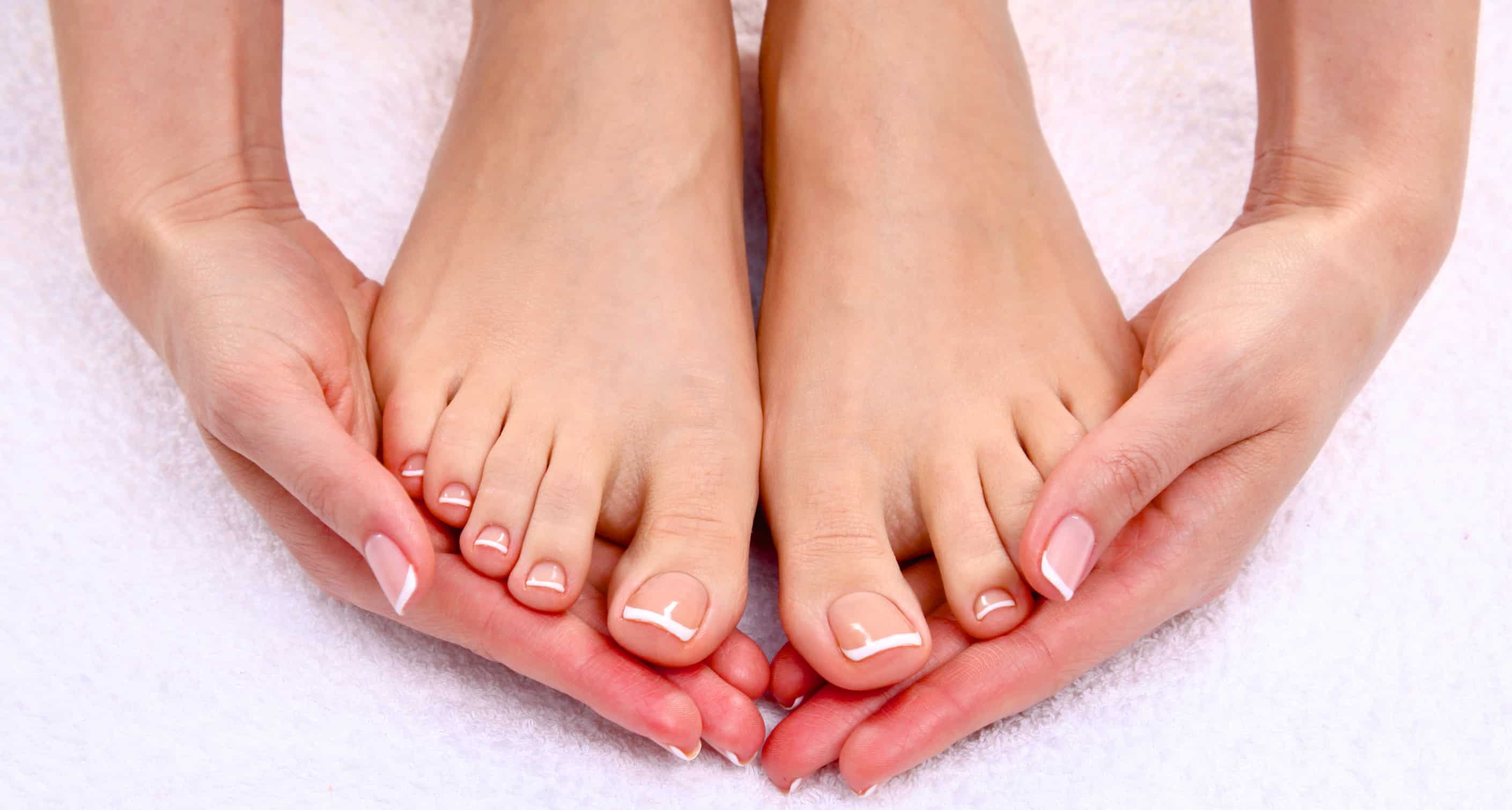
For more information from your local chiropodist on the nail condition treatments that are available, please use the toggle switches below:
Onychauxis is the medical term for thickening of the nail. It is a frequent complaint and can affect all the toe nails. Nail cutting is difficult and if the nail becomes too thick the pressure from footwear can be painful.
Symptoms :-
- Abnormal thickening of the nail plate (usually on the upper part)
- Can become white yellowish or brownish
- Nail edges crumbling
- Difficult to trim uniformly
- Left untreated, may become white, black, yellow or red and painful
- Sub-ungual corns or ulcers with some discharge
Causes :-
- Medical conditions like psoriasis.
- Athletes foot infecting the toe nails (fungus yeasts or moulds).
- Severe trauma to the nails.
- Long term low grade impaction from tight footwear or activities.
- Poor circulation and metabolic change
- Oedema due to poor venous return
- Diabetic patients are more prone.
Onychauxis can be a secondary symptom of a larger problem, so it shouldn’t be dismissed too easily. Other causes include Acromegaly, Darier’s Disease and Pityriasis Rubra Pilaris.
Treatment :-
- Keeping the nails nice and short (frequent trimming)
- Filing down with sterile burr
- Low level laser therapy
- In severe cases the nail can be removed under a local anaesthetic
Your local Chiropodist at Market Street Clinic have over 18 years experience with treating onchauxis with Low Level Laser Therapy and over 20 years with nail removal under local anaesthetic.
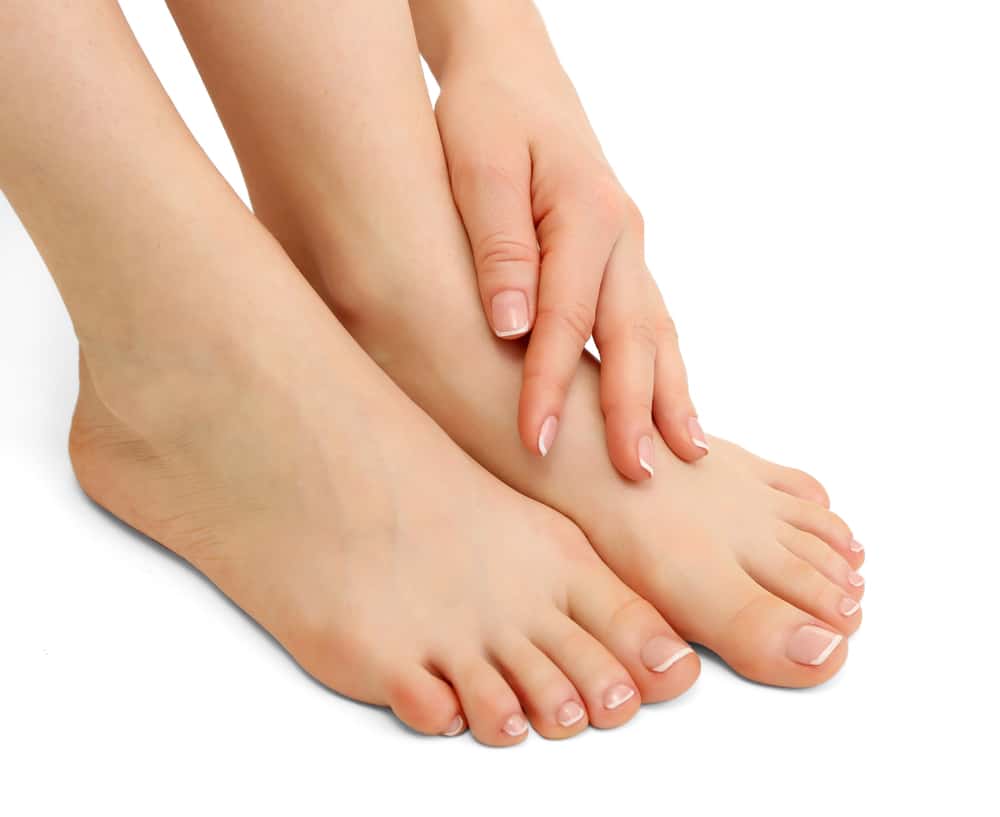
Onychomycosis is a fungal infection that occurs as a result of the fungi that cause athletes foot, infecting either the fingernails or toenails while usually spreading from the skin. Dermatophytes are the most prevalent fungi that infects the foot. Fungal infections normally develop over time, so any immediate difference may not cause any obvious signs at first.
Symptoms :-
Fungal toe nails often appear to have white yellow or brown patches and may alter in its structure. It can affect a small part of the toe nail or the whole the nail sometimes making it thick crumbly and brittle and very difficult to cut.
As it progresses, the infection can cause :-
- Discolouration of the nail – it may turn white, black, yellow or green
- Thickening and distortion of the nail – it may become an unusual shape and be difficult to trim
- Pain or discomfort – when placing pressure on the affected nails
- Pieces may crumble, break off and come away completely
- The surrounding skin may also become infected and become itchy, flaky dry or red and swollen.
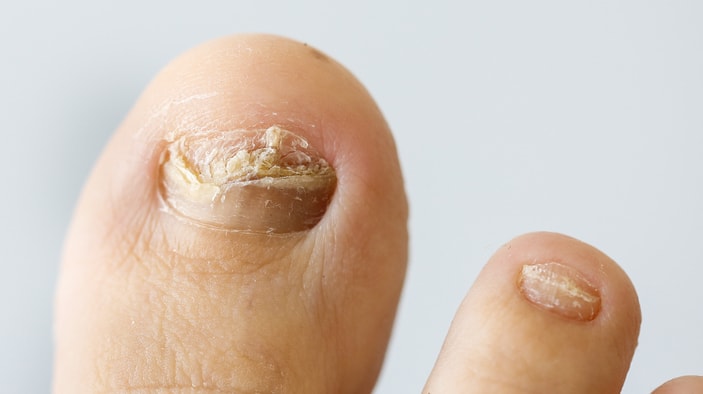
Causes :-
- You’re more liable to get a fungal nail infection if you:-
- Don’t keep your feet clean and dry
- Hot and sweaty feet
- Wear shoes made of man made materials
- Walking barefoot in communal showers, gyms and changing rooms is where most people catch fungal infections
- Injuries
- A weak immune system
- Diabetes, psoriasis, obesity or peripheral arterial disease
- Living in hot and humid climates.
- Severe injuries to the nail may also lead to a bacterial infection
Communal areas where there are showers changing rooms and gyms are where people are most likely to come in to contact with this type of infection. If you get a manicure or pedicure at a nail salon, be sure to ask how the staff disinfects their tools and how often they do it. Tools, such as emery boards and nail clippers, can spread fungal infections from person-to-person if they’re not sanitized.
Prevention:-
You can reduce your risk of developing a fungal nail infection by:-
- Keeping your hands and feet clean and dry
- Well-fitting shoes and clean socks made of natural materials
- Keeping the nails short
- Using your own clippers and towels and not sharing with other people
- Wearing flip flops or protective shower shoes in communal areas
- Replacing infected footwear or have them sanitised
- Treat athletes foot as soon as possible to prevent the infection spreading to your nails
- Nail salon equipment can sometimes be the source of fungal nail infections. If you regularly visit a salon, make sure any equipment used is properly sterilised between uses.
- Fungal nail infections can be spread to other people, so you should take steps to avoid this if you have an infection.
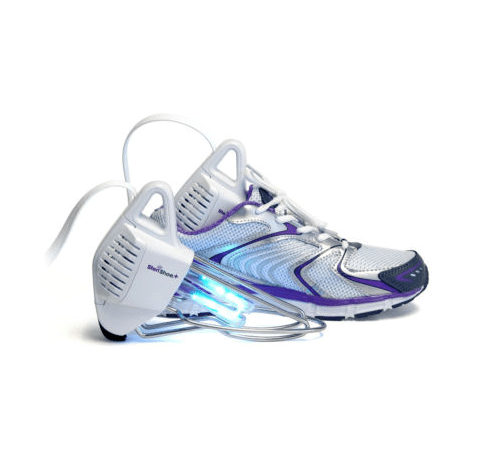
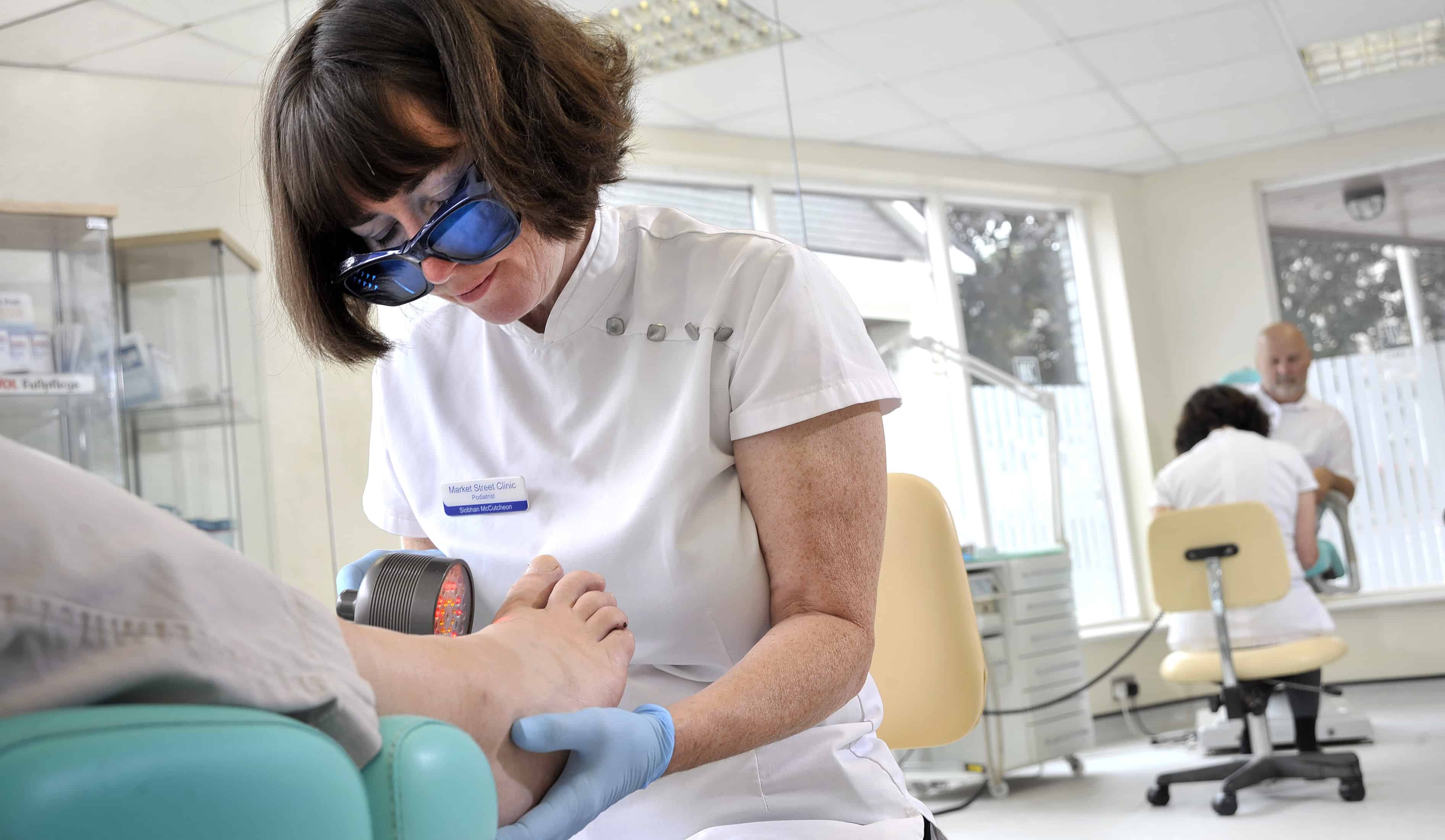
Treatments :-
- Oral anti fungal medication (possible side effects)
- Nail Laquer (we have not found this to be very successful)
- A procedure to remove the nail completely may be recommended in severe cases
- Low level laser treatment, where a high-energy laser is used to destroy the fungus.(no side effects)
Treatment or not, you should still practise good foot hygiene to stop the infection getting worse or spreading to others.
A Podiatrist will be able to diagnose fungal nails and advise on the appropriate care plan.
At Market Street Clinic we have Low Level Laser therapy for the successful treatment of fungal nails and a UV shoe steriliser to clean and deodorises shoes with UV lights for disinfecting shoes. All our equipment is sterile.
Daily Mail article on Low level laser therapy link:-
http://www.dailymail.co.uk/health/article-2110800/Pain-free-laser-banishes-toenail-fungus.html
Results of gov clinical trials on Low level laser therapy :-
https://clinicaltrials.gov/ct2/show/NCT01534689
Market Street Clinic Low Level Laser Therapy treatment results
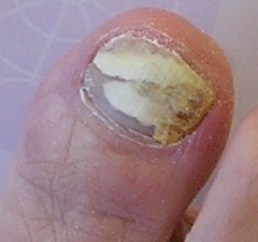
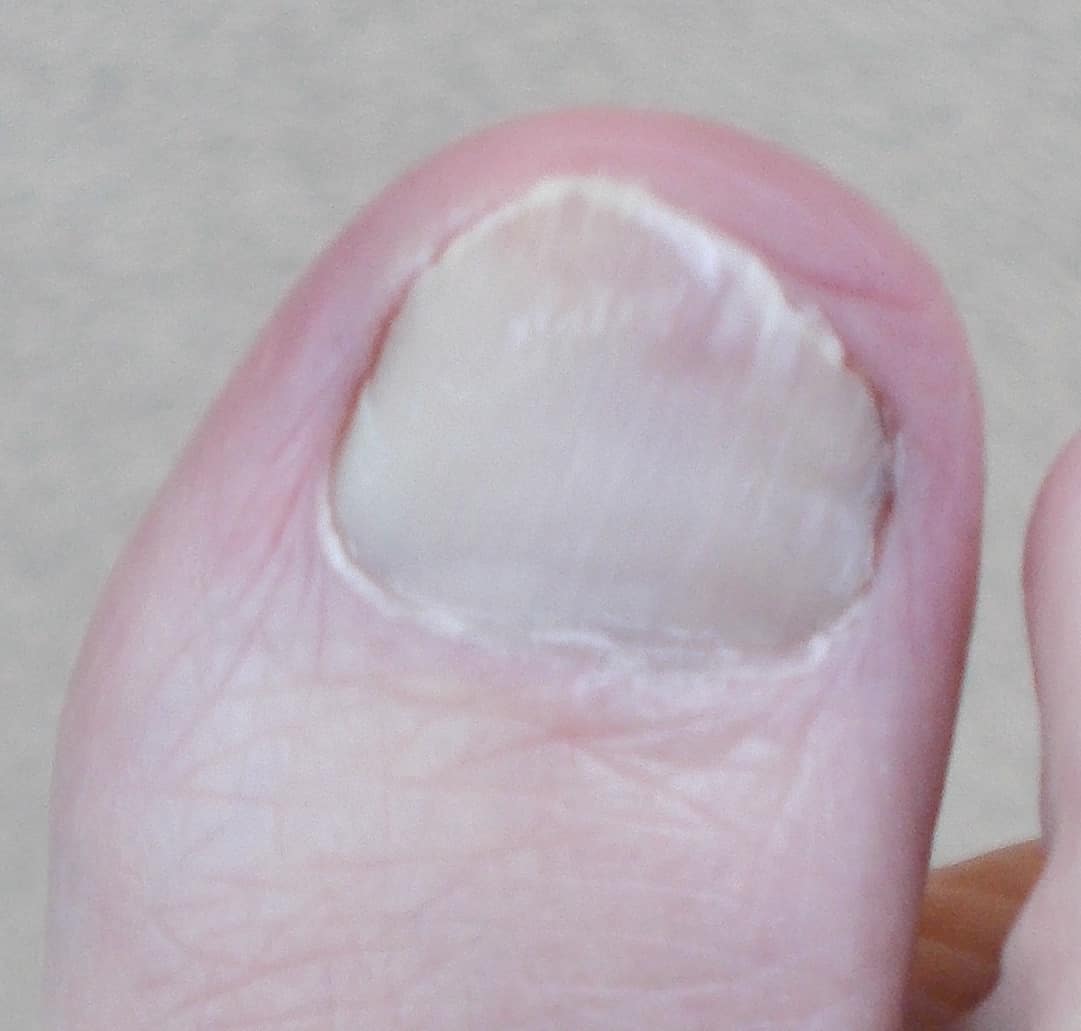
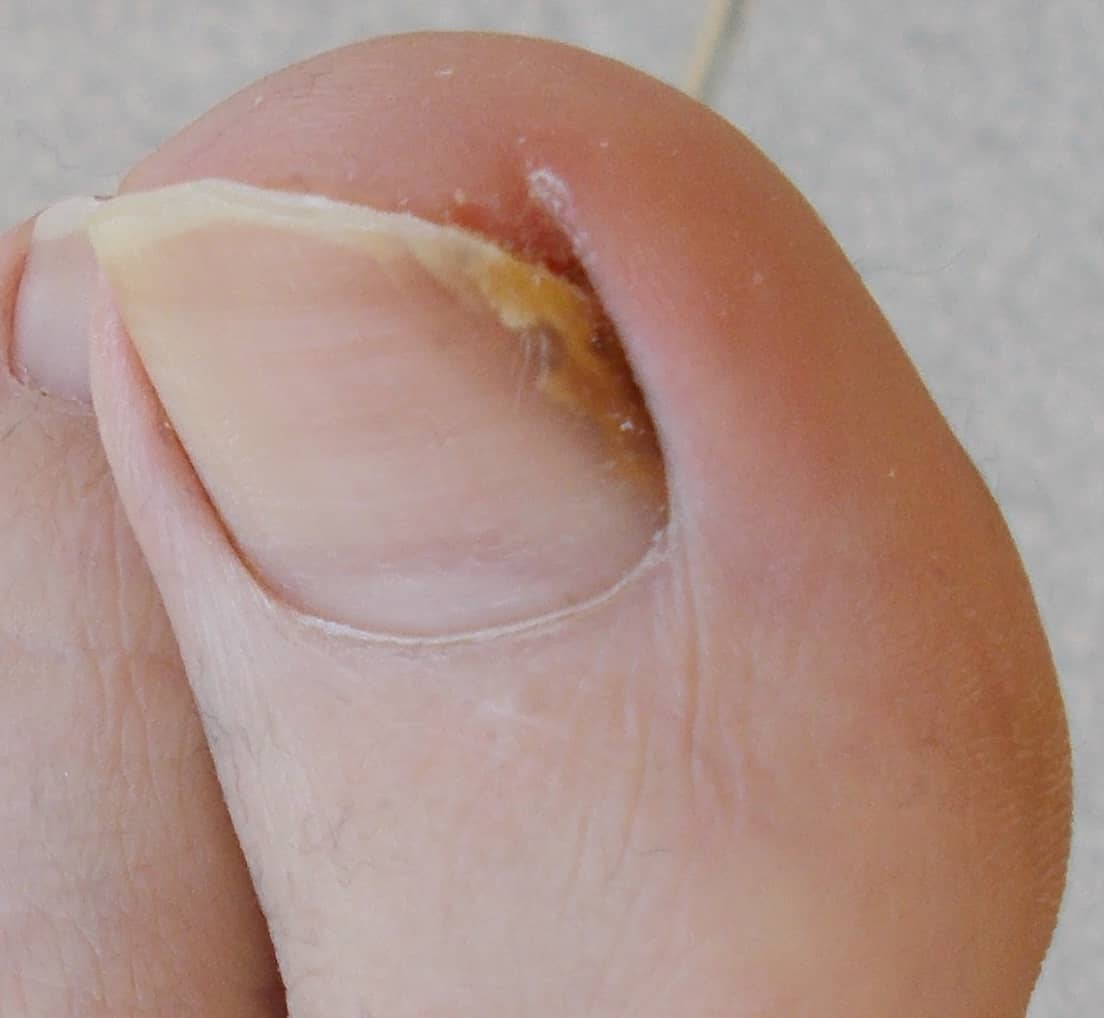
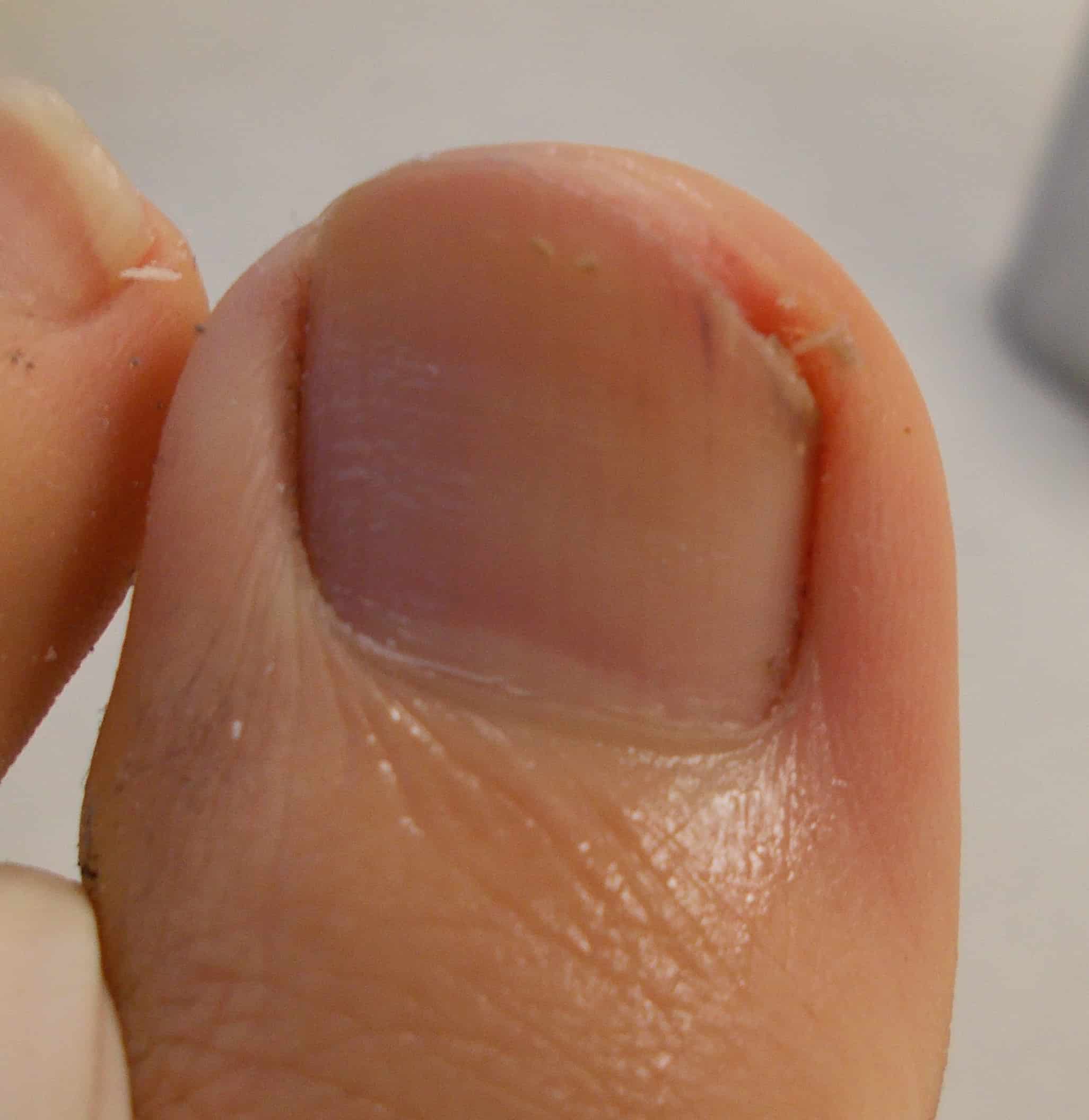
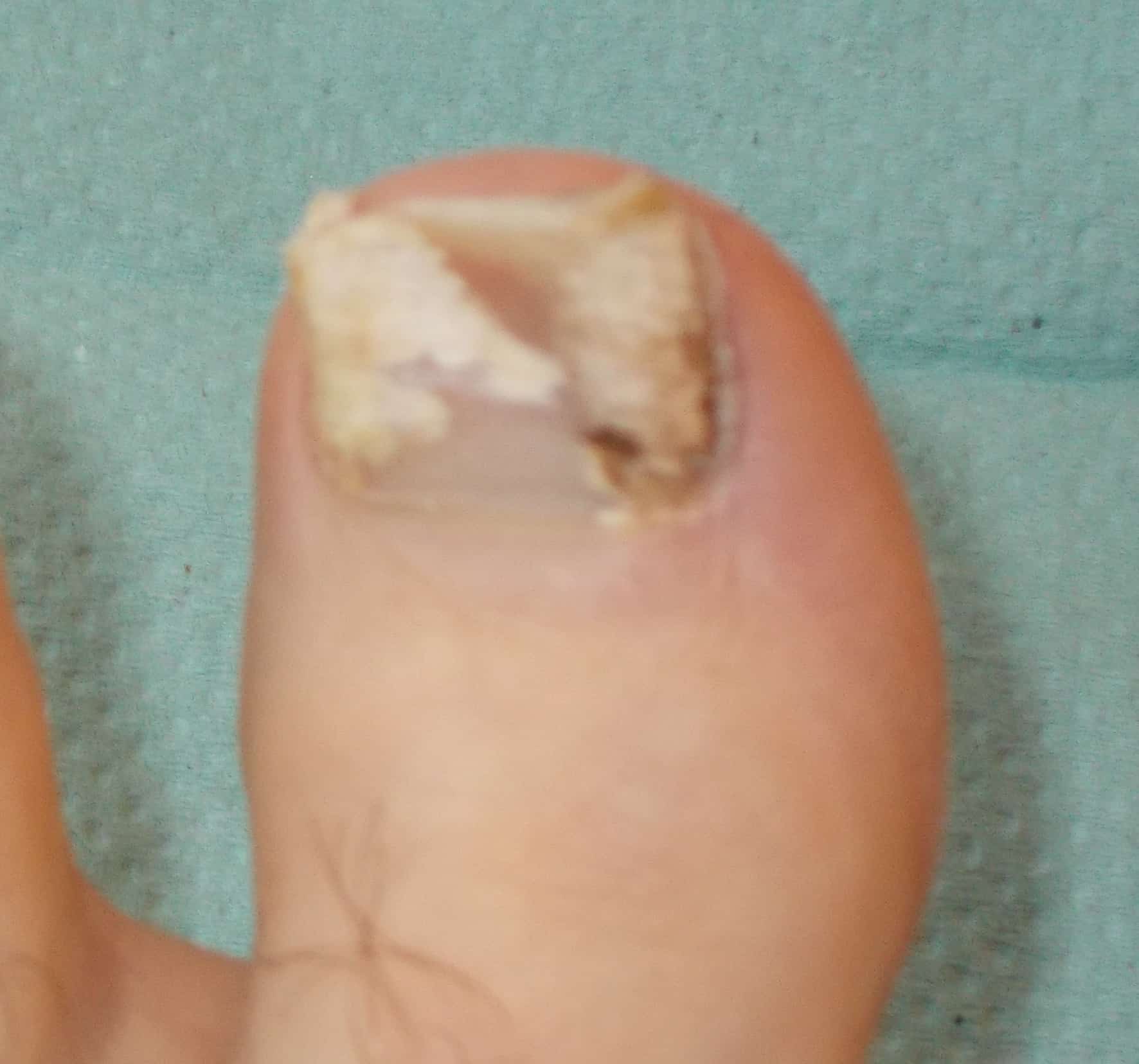
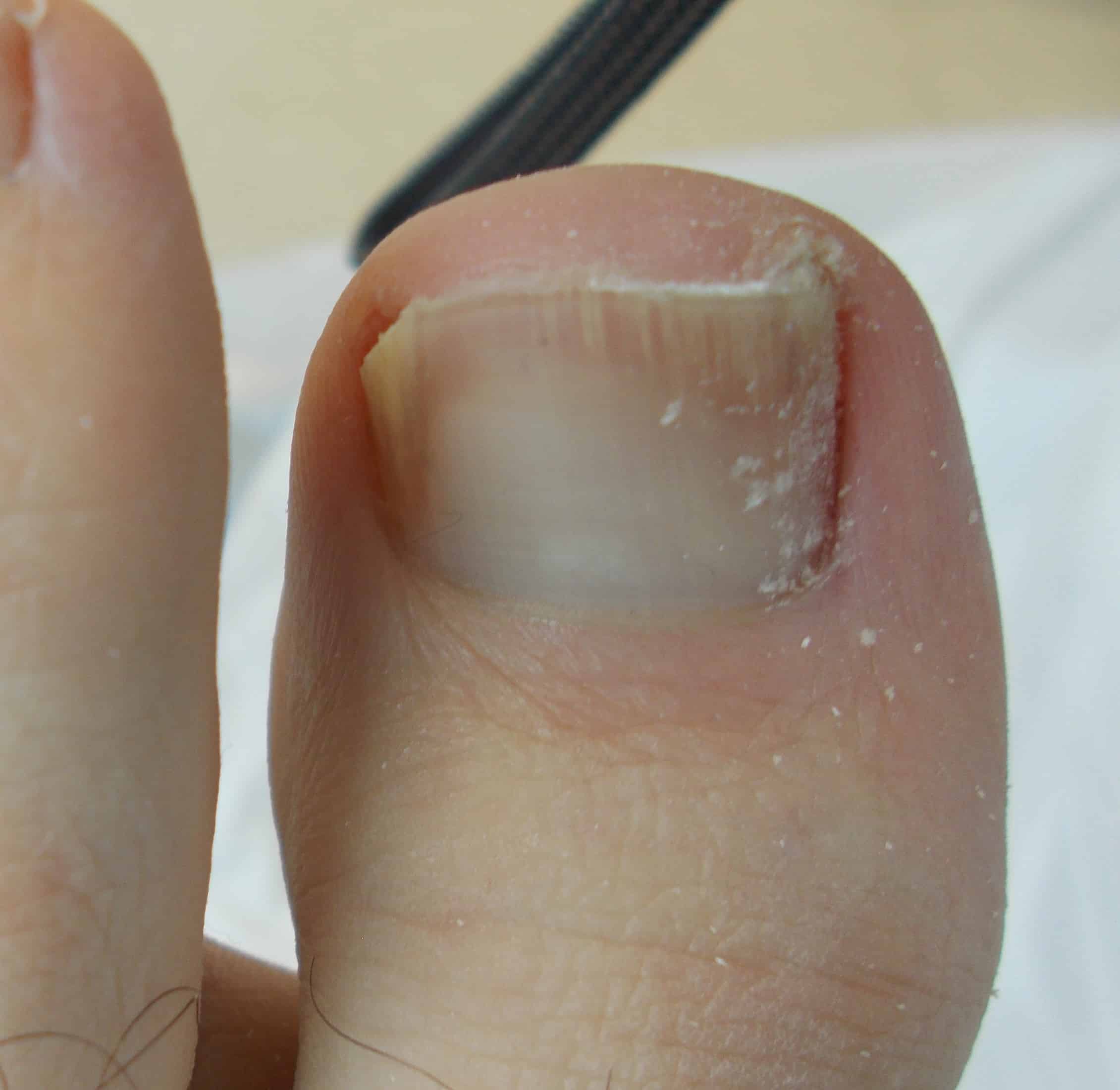
1 before and after
2 before and after
3 before and after
When you go for your laser nail treatment, be sure to bring clean socks to wear after your laser toenail treatment and ask for your shoes too be sanitized. That way your newly treated toenails will go back in a healthy, germ-free shoe.
An involuted toe nail is when the edges of the nail plate curve towards each other squeezing the flesh underneath causing considerable pain and discomfort even with the slightest pressure.
Involuted toenails are very common. Genetics often determine the shape and structure of the nail, although significant trauma can damage the nail matrix causing it to develop into an involuted toe nail. An involuted nail on the large toe has far more potential to become symptomatic than on the lesser four toes. Injuries and/or over zealous pedicures can aggravate this type of nail. Foot wear that is far too tight is another common cause. Although there are people with involuted nails who never have any symptoms, those that have, will likely experience periods of pain.
In severe cases the nail will become too embedded and painful for self treatment, and this is the when people require treatment from a Podiatrist. At this stage the nail may have become inflamed, possibly with localised infection and granulation tissue, causing an ingrown toe nail.
This particular problem can be controlled and improved with regular Podiatric treatment however in severe cases where regular treatments are not easing the symptoms a total or partial nail avulsion under local anaesthesia to stop the offending nail re-growing may be recommended and greatly enhances the quality of life and reduces long term treatment costs.
Causes :-
- Hereditary
- Curly toe nails
- Tight foot wear
- Toenails that have been cut incorrectly
- Thickened toenails
- Trauma
Symptoms :-
- Redness around the toenail
- Swelling of that specific toe
- Pain and tenderness along both sides or one side of the toenail
- Infection of the skin around the toe
People with poor circulation and diabetes, are at risk of further complications.
Self help treatments:-
- Salt foot bath daily.
- Topical antibiotic cream with a sterile dressing applied
- Wear open toe shoes until toe has healed.
- For severe infections oral antibiotics.
Treatment :-
- Removal of the offending piece of nail
- In severe cases partial/total nail avulsion under local anaesthetic.
Before treatment it is advisable to have a warm salt foot bath and apply a sterile dressing. Surgery is a permanent solution to the problem. After surgery the appearance of the nail will appear as normal only slightly narrower.
The podiatrists at Market Street Clinic have carried out 100’s of successful nail surgery operations in the past 20 years.
Some people have toe nails that are grossly deformed so much so that they resemble rams horns. Onychogryphosis, is the medical term for this condition. This is very common in the elderly when their toe nails grow far too long and their feet are neglected. The toenails become thickened and deformed making them difficult to cut and uncomfortable in foot wear.
Toe nails can become deformed due to injury because the cells in the nail matrix have been damaged. The elderly in particular can sometimes become absent-minded or just cannot manage nail cutting any more due to arthritis, weight gain or poor eye sight. However any age group can develop gryphotic nails for different reasons.
Symptoms :-
- Nails become thickened and deformed just like rams horns.
- Dark yellowish and pale brown in colour
- Unable to cut nails
- Tends to be hollow with a build up of debris under the nail
Causes :-
- Neglect ( the elderly, people who are homeless or have psychological illnesses )
- Pressure on the nail over a long period of time caused by poorly fitted shoes.
- As a result the nail grows unevenly developing a curve like a horn.
- Severe trauma to the toe damages the nail matrix
- Fungal infection
- Poor circulation
- Psoriasis
- Syphilis
- Some skin conditions
- In rare cases be present at birth and genetic in origin.
Complications :-
If left untreated, the nail can eventually grow into the skin, causing pain and inflammation, and increasing the risk of a bacterial infection. Rough thick nails may damage the nail bed causing ulcerations or sores to develop. Diabetic patients with loss of feeling in their feet are particularly at risk. The nail may also be more prone to fungal, yeast or mould infections.
Prevention :-
- Regular nail cutting
- Well fitted foot wear
Treatments :-
- Regular visits to the Podiatrist who will cut and reduce the thickness of the nail .
A Podiatrist can gently reduce the thickness and keep the toe nails at a reasonable length to prevent problems occurring . In severe cases a total nail avulsion under local anaesthesia may be necessary. This is permanent removal of the nail.
A nail that is allowed to grow from a matrix that has been damaged in this way will continue to thicken as before and may not adhere properly to the nail bed.
Ingrown toenails are one of the most common complaints seen by Podiatrists They are very painful, and need specialist treatment, as they cannot resolve by themselves. They can be acute, and occur due to an injury to the toe, or they can be chronic, which means the patient has had the problem for a long period of time.
The large toe is usually the one which is affected, however, it can also affect the smaller toes. An Ingrown toenail is when a splinter spike or side of the nail grows Into the skin at the side of the toe. It more common in teenagers and young adults, however it can affect any age group.
It’s also important to seek medical advice if you have diabetes and an ingrown toenail. Having diabetes could affect how your toenail heals.
Causes :-
- Poor nail cutting
- Involuted or fan shaped nails
- Sweaty feet
- Injury
- Tight footwear socks and tights
- Fungal toe nail
- Thickened nails
Symptoms :-
- Pain, if pressure is applied to the toe
- Red and hot to the touch
- Inflammation and peeling of the skin at the end of the toe
- Build-up of fluid in the area surrounding the toe
- Overgrowth of skin called granulation tissue around the affected toe
- Bleeding
- White or yellow pus coming from the affected area
- Infection
- Unpleasant smell
Treatment :-
Treatment involves removing the offending bit of nail. In severe cases nail surgery is done under local anaesthetic which is a relatively painless procedure that removes the whole nail or only a section of it and a chemical is used to prevent that portion of the nail from re-growing thus preventing the problem ever reoccurring. Cosmetically this is a very effective technique. The whole procedure takes about an hour and is performed on a day care basis, meaning no overnight stays in hospital and minimum disruption to your everyday life. Normal activities can resume very soon after the operation. Total healing can take between 4 – 6 weeks. Without treatment, an ingrown toenail can become infected.
Total nail avulsion may be necessary if your nail is thick and pressing into the skin surrounding your toe.
After surgery :-
After toenail surgery, your toe will be wrapped in a sterile bandage. This helps to stem any bleeding and prevent infection. Rest your foot and keep it raised for one to two days after the operation.
To help reduce the pain, you may need to take a painkiller, such as paracetamol or ibuprofen, and wear soft or open-toed shoes for the first few days after surgery.